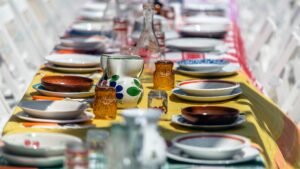Article initially published on Anvarta.

Dinner sets, tea sets, cutlery, plates, and dishes – You may have received them as a gift or purchased them at your fancy, yet one common thing is that they needed to match, or in other words, be a complete set.
“Match” is a tricky word we usually tend to associate with similar things when it comes to sets of items available in a pack. There is often the tendency to have them in packs of 4, 6, 8, 12, or 18. The bad part about these things coming in a pack is that when one breaks, it creates a feeling of “incompleteness” with the user. Marketing research suggests that people generally prefer to buy things as a package or pack and that is often a strategy used to promote and sell more items by producers.
In one study when participants were presented with a four-pack container, pre-filled with one, two, or three bottles of beer—they overwhelmingly said that they would purchase only the extras needed to fill all four slots, no more and no less (Barasz et al., 2017). The discomfort created by incompleteness is real!

What is likely to happen when a cup of a 4-piece tea set breaks may be different from what happens when a plate of an 18-piece plate set breaks. With the first one, there is the realization that you may not be able to provide tea for a family of four anymore and that may trigger a new purchase of another complete set sooner.
But does the “matching” need to be accomplished with identical designs? Can producers produce somewhat standardized, yet can be differently matched items? Or more importantly, as consumers can we still feel “complete” if we complete a set with mismatched items?
Here are a few things that you can do as a consumer
1. Associate your preference with the item itself, not the matching set
Pick the ones that you like best, and feel free to love them. If you break one, there is no need to lose the whole set, as you still have the option to use what remains.
2. Make it a lifestyle, do not associate with affordability
You may have money to afford a new set, but the temptation you need to manage is whether you should. The happiness you associate with still having the items you liked best, even though it’s imperfect, and the benefit you do to the environment (and the pocket) by not purchasing another should outweigh the trouble of finding another matching set.

3. Declare your choice upfront to visitors and guests
How we will be perceived when serving guests with unmatching cutlery is a concern we might have? Would it be seen as a lack of preparation or respect? But, tackling it is easy – Be bold enough to tell why you do it when you lay out the table or offer tea. You may end up being an ambassador of a message of regeneration.
4. Favor the brands that provide mismatching options that go together
Brands that offer options for mismatching items to match are something to seek and favor in the long run. Sellers need to develop the capability to offer exit to consumers (such as return an earring of a lost pair and get another set) or options to mismatch. Different patterns in the same color, the option to purchase one or many, custom order a replacement at a reasonable price are a few things producers can do to help improve this trend.
5. Gain awareness of alternative sources and schemes to purchase
It is a great idea to know where the local op-shops (or recycled items stores as we call it technically) are at because they may have several mismatched options that match. Using subscription or renting for occasions is another great alternative, where you may even get the chance to find similar matching items without having to own them at all and get a chance to have mismatched sets at your discretion for day-to-day household consumption. If we think about it deeper, a match is what we define and find appealing- rather than a set of identical items. That definition and appreciation is something we all can do, whether we have similar items or not.
Follow Anvarta for more resources for brands and producers on the “Matching does not need to be identical” theme.